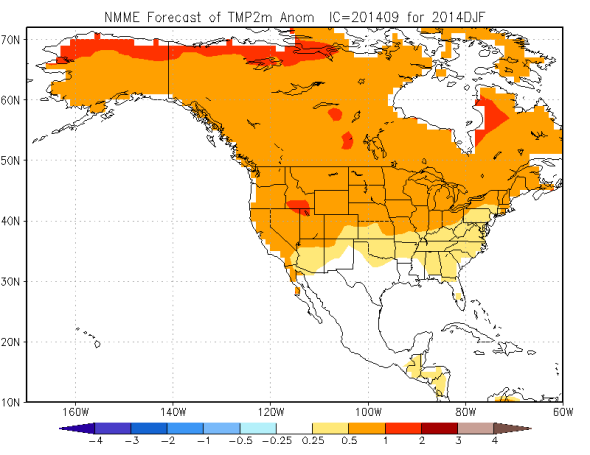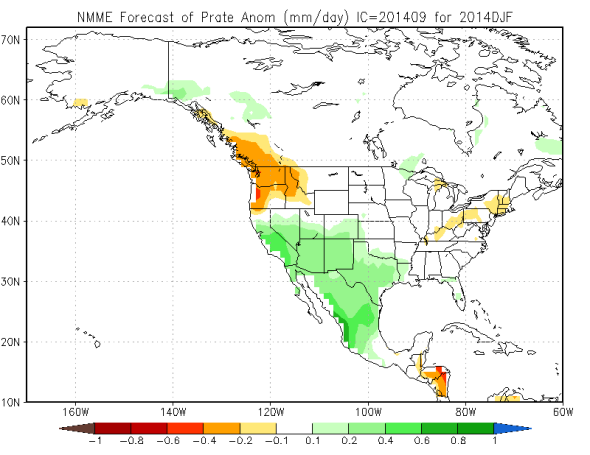
Oh No, This Is Exactly How Last Winter Started

In case you haven’t checked the calendar lately, it’s technically still summer. So how do you explain this?
Winter (complete with a snowman army) has invaded Calgary! #snow Photo via @jpmwd pic.twitter.com/ecHUaqkeuM
— Miranda Hilgers (@mhilgersWX) September 10, 2014
Summer snow blankets Rockies from Canada to Colorado http://t.co/lDswY9jONX
— ap rosebud (@aprosebud) September 10, 2014
Way too early for this. Even the Presidents look like they are crying... #SDwx pic.twitter.com/0WFA5vGU7x
— Brandon Spinner (@wxSpinner89) September 11, 2014
Near an inch of snow at Rapid City. This is the earliest recorded snowfall going back to 1888. #sdwx pic.twitter.com/xUetPL4tQY
— NWS Rapid City (@NWSRapidCity) September 11, 2014
Yep, you read that right: In 126 years of weather records, it’s never snowed this early in Rapid City, South Dakota. Some higher elevations just to the west of town got up to 8 inches, according to a National Weather Service report.
Tonight, Denver is expecting snow, too. If it falls, it’ll be the third earliest snowfall there on record.
#Snow is forecast to move as far south as NE Colorado tonight before ending tomorrow morning. pic.twitter.com/yYIE0czP8q
— NWS WPC (@NWSWPC) September 11, 2014
I can assure you that are *not* typical wind chills for mid-day in early/mid SEPT! #COwx #weather #Denver #COLD pic.twitter.com/uRO9Qbq17M
— Josh Larson (@coloradowx) September 11, 2014
The cold and snow were well forecast (I tweeted about it back on Monday), but that doesn’t take away the pain. If you live in the Northeast and think you can safely file this weather weirdness as something that’s just happening “Out West,” think again: Temperatures will dip into the 40s this weekend in the outskirts of New York and Boston, about 20 degrees colder than average for mid-September.
Last year, a similar early season Dakotas snowfall kicked off the epic winter (replete with polar vortices) that most of us would rather forget. So, are we in for something similar this year? Have I angered the Farmers’ Almanac gods?
To be completely honest, last winter’s crazy weather—cold and snowy in the East, warm in California—has never really gone away. Consider:
- Ice lingered until June this year on Lake Superior.
- In July, another round of the polar vortex broke all-time monthly cold records across the South.
- This summer was the hottest on record for Northern California as that state’s drought continued to expand. Since at least early 2013, a semi-permanent kink in the jet stream has left California behind, instead shunting rain clouds as far north as Alaska. (Amid this week’s September snowstorm, temperatures will be in the 90s along the West Coast, as far north as Portland.)
On Thursday, the National Climatic Data Center released its monthly U.S. climate report for August, whose graphics are virtually indistinguishable from any of the last dozen or so months: record-breaking heat out West and unseasonable chill in the East. Thanks to its eerie longevity, this weather pattern even has its own name: the Ridiculously Resilient Ridge.
The source of the RRR can be traced to a continent-sized blob of abnormally warm water just off the Pacific Coast. Since the ocean and atmosphere work in tandem to produce our daily weather, that means effects are being felt thousands of miles downstream.
Weather and climate scientists have released new research over the last few months showing a counterintuitive connection between persistent and extreme winter weather patterns and global warming. The melting Arctic has a lot to do with it, but scientists are still debating the details.
So, sticking to the science, what can we actually expect for the coming winter?
Using the Climate Prediction Center’s freshly updated long-range model suite, now’s as good a time as any to take a first guess. These models take into account semi-stable patterns of ocean temperatures to predict areas of relative drought and excess rain and warmth and frigidity over the next few months, and their historical accuracy is better than a random guess.

Image: CPC NMME

Image: CPC NMME
However, these maps don’t tell the whole story. Looking past December, the sub-models have a lot of variability, and some of them are looking a bit polar vortex-y. I’m running the risk of sounding Almanac-vague here, but I think you can bet on at least a few serious cold snaps during January and February. By and large (especially for the West Coast), though, it’ll thankfully be as warm if not warmer than last winter. Of course “warmer” is a relative term mid-January. Again, it’s a bit early to go on the record with a winter forecast, but I thought circumstances warranted a reality check. Seasonal weather forecasting is best thought of as a spread of probabilities, so, just think of the odds tilted slightly toward warmth this coming winter.
Last year at this time, these models were hinting at something pretty close to what actually happened, and that consistent Eastern cold signal isn’t showing up this year. So, despite this early season winter blast, I’m increasingly confident that a record-breaking winter like last year’s isn’t impending. When exactly the occasional (and inevitable) polar vortex comes along, though, is anyone’s guess.
Let’s Turn Off the Internet Every Sept. 11
This Sept. 11 is just a little over two-thirds over on the East Coast, and it’s already thoroughly nauseating. This is due in large part to corporate social media accounts, and brands’ insistence on marking the anniversary of the deadliest terrorist attack on American soil with tweets and ads that come across as queasily incongruous at best. (At worst, they are shockingly opportunistic, like Bikram Arlington’s instantly famous “9+11 = 20% OFF!” tweet.) Meanwhile, editors at every blog and news site (including this one) have looked for new angles on the attacks of 13 years ago, publishing or re-publishing rote essays about how 9/11 changed [fill in the blank]. Everyone feels that they must say something new about 9/11, even though no one has anything new to say.
I have a proposal for preventing this distressing state of affairs: Shut down the Internet for 24 hours every year on Sept. 11.
This might seem like a disproportionate (not to mention impractical) response, but would it really be so bad to go without Internet access for a day? Think about the things most of us use the Internet for: reading blogs, tweeting, Facebook stalking, watching funny YouTube videos, ordering clothes or gadgets on retail sites, watching porn, sending emails. No one needs to do any of these things on Sept. 11. (Emails, you might argue, are harmless, which is true, but why not just text or pick up a phone?)
Most of the things we do online are means of distracting ourselves from existential angst, but if ever there’s a day for confronting our existential angst instead of running from it, it’s Sept. 11. After all, fear, anger, and sadness are never far from the surface on Sept. 11. The tension between these feelings and the trivial absurdities of everyday life is the reason we feel unsettled seeing the masturbatory aid company Fleshlight use the hashtag #911neverforget. Better not to let Fleshlight—or anyone else—tweet anything at all, so that everyone can process their feelings about Sept. 11 without diversions.
I’m not suggesting that everyone should mark Sept. 11 in the same way: 9/11 means different things to different people, and temporarily shutting down the Internet would allow people to do whatever feels authentic to them. Imagine if you couldn’t get online today: You might choose to read the newspaper, go to the office (and actually get work done instead of procrastinating for once), go to a protest, walk your dog, call your sister, write a letter to a congressperson, visit the 9/11 Memorial. You could still do pretty much anything you choose. You just wouldn’t risk coming across a Spotify playlist called “In Remembrance,” or a BuzzFeed listicle called “27 Moving Images of the Nation Remembering 9/11,” because such things wouldn’t exist.
How would an annual national Internet blackout work? I’m not sure. It’s unlikely Internet service providers would suspend service en masse (although, given the proposed Time Warner-Comcast merger and general lack of competition in the industry, it’s not entirely out of the realm of possibility). Perhaps individual websites could voluntarily close up shop, in the hopes that others would follow. It would be a constitutional nightmare for the federal government to pass a law banning online discourse on Sept. 11, but maybe the government could nudge everyone in the right direction by suspending all government social media accounts and temporarily taking down all but the most vital .gov sites.
Of course, Internet users could always boycott cyberspace on Sept. 11 every year. The only problem with this approach is that the most cynical and tone-deaf tweeters and publishers would continue to tweet and publish regardless of the boycott, and we’d have to confront the aftermath when we logged back in on Sept. 12. That’s why a wholesale shutdown is the best approach: It would save us from the Bikram Arlingtons of the world, and would save them from themselves.
Join Neal Stephenson, NASA’s Chief Scientist, and More for a Future Tense Event on Sci-Fi

It’s 2014 and we have no flying cars, no Mars colonies, no needle-less injections, and yet plenty of smartphone dating apps. Is our science fiction to blame if we find today’s science and technology less than dazzling?
On Thursday, Oct. 2, Future Tense—a partnership of Slate, the New America Foundation, and Arizona State University—and Issues in Science and Technology will host an event to explore a more ambitious narrative about what’s coming. The event is inspired by sci-fi author Neal Stephenson’s 2011 article “Innovation Starvation,” in which he argues that science fiction is failing to supply our scientists and engineers with inspiration, and the new anthology Hieroglyph: Stories and Visions for a Better Future, a project of Arizona State’s Center for Science and the Imagination. From the tales we tell about robots and drones, to the narratives on the cutting edge of neuroscience, to society’s view of its most intractable problems, we need to begin telling a new set of stories about ourselves and the future.
The event will be held in Washington, D.C., and breakfast and lunch will be served. If you are unable to join us in person, please tune in to the live webcast. No signup is required to view the streaming video, which will appear on this page. Join the conversation online using #abetterfuture and by following @FutureTenseNow.
For more information and to RSVP, visit the New America website.
Agenda
9:00 a.m.: Can We Imagine Our Way to a Better Future?
Neal Stephenson
Author, Snow Crash, The Diamond Age, “Atmosphæra Incognita” in Hieroglyph: Stories and Visions for a Better Future, and more
9:15 a.m.: Delivery Drones and Robot Babysitters
Ryan Calo
Assistant professor of law, University of Washington
Patric Verrone
Writer and producer, Futurama
Dan Kaufman
Director, Information Innovation Office, DARPA
Moderator:
Kathryn Cramer
Editor, Hieroglyph: Stories and Visions for a Better Future
10:00 a.m.: Who and What Will Get to Think in the Future?
Ted Chiang
Author, Stories of Your Life and Others
Moderator:
Ed Finn
Director, Center for Science and the Imagination, Arizona State University
10:20 a.m.: Neuroscience and the Future of Ethics
Elizabeth Bear
Author, “Covenant,” Hieroglyph: Stories and Visions for a Better Future
Jonathan D. Moreno
David and Lyn Silfen university professor of ethics, Perelman School of Medicine, University of Pennsylvania
Kathleen Ann Goonan
Author, “Girl in Wave: Wave in Girl,” Hieroglyph: Stories and Visions for a Better Future
Moderator:
Jamelle Bouie
Staff writer, Slate
11:05 a.m.: Who Gets to Imagine for the Human Race?
Tom Kalil
Deputy director for policy, White House Office of Science and Technology Policy
Laurie Silvers
Founder, SyFy Channel and Hollywood Media
Moderator:
Bill O’Brien
Senior adviser for program innovation, National Endowment for the Arts
11:50 a.m.: Lost in Space: How Should We Approach Our Final Frontier?
Ellen Stofan
Chief scientist, NASA
Neal Stephenson
Author, Snow Crash, The Diamond Age, “Atmosphæra Incognita” in Hieroglyph: Stories and Visions for a Better Future, and more
Moderator:
Patric Verrone
Writer and producer, Futurama
12:35 p.m.: Lunch
1:00 p.m.: Reimagining the Future of the Internet, Surveillance, and Privacy
Barton Gellman
Reporter at the Washington Post covering the Snowden papers
Author, Angler: The Cheney Vice Presidency
Madeline Ashby
Author, “By the Time We Get to Arizona,” Hieroglyph: Stories and Visions for a Better Future
Kevin Bankston
Policy director, Open Technology Institute, New America Foundation
Moderator:
Kristal Lauren High
Co-founder and editor in chief, Politic365
1:45 p.m.: Visions of an Alternative Internet
Lee Konstantinou
Author, “Johnny Appledrone vs. the FAA,” Hieroglyph: Stories and Visions for a Better Future
2:00 p.m.: Can Stories Solve Wicked Problems that are Bigger than our Imagination?
Vandana Singh
Author, “Entanglement,” Hieroglyph: Stories and Visions for a Better Future
David Rejeski
Director, Science & Technology Innovation Program, Woodrow Wilson International Center for Scholars
Karl Schroeder
Author, “Degrees of Freedom,” Hieroglyph: Stories and Visions for a Better Future
Moderator:
Dan Sarewitz
Co-Director, Consortium for Science, Policy, & Outcomes
2:45 p.m.: Does Your Government Have an Imagination?
Rep. Zoe Lofgren
House of Representatives, CA-19
Google's High-Tech Spoon Could Help People With Parkinson’s
Google has taken a break from buying robots, drones, and artificial-intelligence companies to acquire Lift Labs, a small startup that makes spoons.
As you can see in the video below, Lift's spoons are not your ordinary flatware. They’re designed for people whose hands shake, whether from essential tremor or a neurodegenerative disorder such as Parkinson’s. Embedded in their oversized handles is an electronic system that senses the tremors and responds with counter-movements designed to keep the spoons’ business ends relatively stable. The handle moves, but the business end stays relatively stable, so the food doesn't fall off on its way to your mouth.
The Lift Labs spoon costs $295 and you can buy it here. The company is also working on soup spoon, fork, and key holder versions.
Cool, right? But what does that have to do with Google?
Well, as Reuters’ Alexei Oreskovic points out, Google has been taking a greater interest in health technology lately, and Lift will be joining a growing Life Sciences group within the company. That group, profiled recently in the Wall Street Journal, is working on a “smart contact lens” that monitors glucose levels for diabetics. Google also led a $130 million investment earlier this year in a startup that produces cancer treatment software.
More broadly, Google appears to believe that some of the same computing technologies it has developed to organize the Internet could be used to make better sense of the human body. Last year it launched a whole new company called Calico with the goal of fighting old age.
But there’s another, more personal reason why Google might have been attracted to Lift Labs in particular. Sergey Brin’s mother was diagnosed with Parkinson’s, and Brin himself carries a gene that’s associated with the disease. In 2010, Wired’s Thomas Goetz wrote about Brin’s quest to harness software and computing power to help find a cure for Parkinson’s.
In a statement on Google Plus, the company wrote of Lift Labs:
Their tremor-canceling device could improve quality of life for millions of people. We’re also going to explore how their technology could be used in other ways to improve the understanding and management of neurodegenerative diseases such as Parkinson’s disease and essential tremor.
Previously in Slate:
Insurance Companies Want to Use Your Personal Data to Determine Your Premiums
Maybe you've been wearing a FitBit for a while, or you were the first person in your neighborhood to install a Nest smart thermostat. But for the most part, the quantified-self and smart home movements are still in their early stages. For insurance companies, though, there’s big incentive to move things along.
Health, home, and car insurance companies are all beginning to offer programs that give lower premiums to customers who share their own data. If health tracking, home monitoring, or GPS driving analysis shows that someone is a relatively low risk, they can pay less to be insured. But if the data show negative trends, insurance companies can jack up costs.
Health trackers can send data to employers and/or directly to insurance companies so employees can show that they are staying healthy or getting healthier, and potentially get lower insurance bills. It’s mutually beneficial in the sense that customers are paying less and insurance companies are reducing their risk of having to pay out during a big medical emergency like a heart attack or stroke.
A recent Daily Herald piece gives the example of a male 260-pound BP employee who used a FitBit to log more than a million steps over several months, during which he lost 70 pounds. The result was an annual insurance bill that was $1,200 cheaper for him. And with quantified-self sensors improving and expanding their features all the time, this scenario may become the norm. You can even see how the new Apple Watch would fit in, since it allows people to share information about their heart beats in addition to collecting typical fitness data.
Car insurance companies can use GPS tracking data from vehicle sensors or smartphones—which are ubiquitous and don’t require installation—so they can determine who is a safe driver and who isn't. Safe driver discounts from companies like State Farm and Progressive already offer better rates if customers don’t make a claim for a certain number of months or years, but tracking can potentially allow discounts to be deeper, and can help insurance companies pick out who is actually driving dangerously, even if it hasn't resulted in an accident yet.
One roadside assistance company, Agero, says it works with seven of the 10 top insurance companies nationwide. Its senior vice president of strategy, Jeff Blecher, told ComputerWorld last week, “The raw data comes to one of our data centers where we do the processing. We then have direct connections into insurance companies. They see the processed data and can make the evaluation on risky behavior to calculate risk premiums.”
And the case of homeowner’s and renter’s insurance is one of the most clear illustrations of how personal data could fundamentally change insurance. If companies have the ability to monitor environmental conditions like temperature and moisture level, they can tell a lot about how a house is being maintained. And especially for higher-risk scenarios like beach-front houses, second homes, or vacant properties, this data could help insurers offer premiums that are calculated with more accuracy.
In all of these scenarios, though, the possibility of cheaper premiums can be a distraction from potential downsides and serious privacy concerns. For example, someone who is committed to losing weight may be unfairly penalized if they struggle to achieve significant results in spite of genuine effort, or a car insurance company could misinterpret unusual driving activity it sees because it doesn't know the context of the other cars on the road.
The New York Times reported in August that in the case of car insurance, people currently aren’t being penalized for being bad drivers, because companies are mainly just trying to entice customers to opt in to data collection. But eventually if everyone is getting discounts, rates may go up. On the flip side, some argue that all of this data collection will undermine the insurance industry's ability to charge arbitrary amounts for premiums. Alex Hawkinson, who cofounded the smart home company SmartThings, told Forbes last month that, “I don’t know if the insurance industry will change their model fast enough. Smart homes absolutely eviscerate the current system. Insurance is a tax on society. It should be less.”
The biggest concern is that mainlining tracking data to an employer or insurance company can unintentionally provide those groups with deep personal information that they shouldn’t have about your activities, interests, and general whereabouts. It may just seem like fitness data, but it's an unprecedented window into your life for people who aren’t necessarily working in your interest.
It may all seem far away now, but there’s big money in personal data and insurance so this isn’t going away. Time to start thinking about what you’d be willing to share, and what you would want to keep private.
Fire, Ice, and Crushing Force Are No Match for This Unstoppable Robot
As if the completely technologically-dependent existence that is our current lives wasn't enough—a world in which the option to employ robotic butlers is, apparently, an imminent (if not optimal) reality—there are now robots with the ability to withstand the harshest of environmental conditions.
As the video above shows, engineers from Cornell and Harvard Universities have developed a "soft" robot that is capable of manuevering its shape-changing body through water, snow, and fire. Additionally, the four-legged bot can also withstand the pressure of being driven over by an automobile. The robot—whose creators hope will have practical applications for search and rescue missions—is also "capable of functioning for several hours using a battery pack or for longer periods with a light-weight electrical tether, and able to carry payloads of up to 8 kg," per a press release from the team.
The science behind the breakthrough, along with a detailed overview of the robot's capabilities, will be discussed in full in an upcoming issue of Soft Robotics. According to the journal's editor-in-chief, Barry A. Trimmer, the "paper marks the emergence of soft robot technology from the research lab into the real world."
For your viewing pleasure, two more videos of the unstoppable robot in action can be seen below.
When Low-Tech Solutions Win
A couple of weeks ago I was traveling through hilly eastern India, visiting remote village communities that survive on a bit of fertile land and mountain streams. At almost every stop I heard stories of stomach viruses and diarrhea epidemics—serious cases that sent dozens of families to far-off clinics.
This crisis, fueled by lack of sanitation and hygiene, accounts for the deaths of 60,000 in India alone and those of 1.5 million children under 5 years old worldwide every year, according to UNICEF. And while the sheer magnitude of the problem can seem insurmountable, one solution might be hiding in a wooden branch, recycled plastic jug, and a bit of soap tied to some rope.
Netizen Report: Chinese Man Sues ISP Because He Can’t Access Google
The Netizen Report originally appears each week on Global Voices Advocacy. Ellery Roberts Biddle, Lisa Ferguson, and Sarah Myers West contributed to this report.
Global Voices Advocacy's Netizen Report offers an international snapshot of challenges, victories, and emerging trends in Internet rights around the world. We begin this week’s report in China, where a man in Shenzhen is suing China Unicom, his Internet service provider, for leaving him unable to access Google online services.The Chinese government instituted a block on most Google products beginning in May, in anticipation of the 25th anniversary of the Tiananmen Square protests. Although Wang Long, a social activist and expert on local law, is unlikely to be successful, he hopes to draw attention to the restrictions through the lawsuit. The court is expected to issue a decision later this month.
Iran: News sites without a license will be blocked
Under recent changes to the Iranian government's already-stringent media regulatory regime, all online newspapers are now required to register with the Ministry of Culture and Islamic Guidance. Although the ministry has yet to define exactly what constitutes a news site, officials announced this week that all sites failing to comply with the measure would be blocked “without discrimination.” Sites that do comply will receive six-month subsidies from the ministry, along with press passes for national events.
Surveillance: German surveillance tech companies are selling most of their products under the table.
After conducting a meticulous review of public data released by the German government, researchers at the Centre for Internet and Human Rights at European University found that the majority of surveillance technologies sold to foreign governments by German companies appear to have been sold without a license. Cross-referencing these findings with technical research by the University of Toronto’s Citizen Lab, they posited that British-German corporation Gamma International exported its highly invasive spyware product FinFisher to countries including Bahrain, Ethiopia, Bangladesh, Netherlands, Estonia, Australia, Mongolia, and Nigeria without obtaining state-required licenses. As they vie for the support of German citizens increasingly concerned about government surveillance, both the Social Democrat and Green parties in Germany are demanding further government regulation of surveillance tech sales.
Internet Governance: Russia to set up its own Internet?
A deputy in the Russian parliament asked the minister of communications to prepare a “civil defense plan” that authorities would deploy if the United States were to shut down the country’s Internet. Although there is no credible evidence that this could or would ever happen, the parliamentarian has used this concern as a rationale for Russia to develop a more autonomous Internet that can function without being connected to the global Internet
New Researcdh
Today Was the “Go Slow” Protest of the FCC Net Neutrality Proposal. Did You Notice?
We’ve all felt the helplessness and frustration of trying to load something and instead getting the spinning wheel of death. But we usually associate it with crummy Wi-Fi or DSL, not net neutrality issues. So open Internet advocates decided to take our built-in visceral reaction and turn it into a tool to protest the FCC’s pending net neutrality proposals before the open comment period ends Sept. 15.
Big tech companies like Netflix, Mozilla, PornHub, and Reddit added an animated loading symbol to their services that says, “If there were Internet slow lanes, you’d still be waiting.” The source code is available so anyone can add the symbol to their site, and the idea was that everywhere you went on Wednesday, you would see that awful spinning out of the corner of your eye.
The initiative is similar to the SOPA/PIPA protests that lead Wikipedia to black out its site for an entire day. But the little load symbols aren’t quite as dramatic a statement as locking users out of a site they want to visit. It seems like the analogous protest action would have involved sites intentionally slowing their services down for a day to let users feel how bad things could be. Indeed, that’s what tech investor Brad Feld proposed back in May.
But Liba Rubenstein, the head of public policy at Tumblr—a company that has been vocal in protesting the FCC proposals—says that simulating the conditions of an Internet slow lane might not seem intentional and could instead frustrate and distract users instead of empowering them to speak up. She explains, “There was a sense that something that was too subtle might actually disturb our users and put them off rather than being a metaphor that draws people in.”
And she says that a comparison to the Wikipedia blackout actually isn’t apt, because that campaign showed an extreme that no one had ever encountered, whereas people deal with frustrating load screens every day:
The blackouts were really something that we hadn’t yet encountered on the Web and that we wanted to try to prevent. The spinning wheel of death is something that people encounter every day. [Right] now we are operating without strong net neutrality protections, and we’ve seen some of our colleagues in the space actually have to live some of those implications that we're all afraid of. You think of a partner like Netflix, their users have had real consequences from these issues that interfere with their ability to use the product. ... It would just be too subtle.
Of course Wikipedia is supported by a nonprofit, whereas for-profit companies have to worry about sacrificing revenue and users if they slow their sites for a day. But if the message doesn't go out loud and clear, some of those sites could slow forever. The protest was far-reaching, but Jon Oliver may still be the one who’s had the most success letting people know what's up.
Your Gmail Probably Wasn't Hacked. But That Doesn't Mean You're Safe.
Several tech blogs on Wednesday reported that hackers have leaked some 5 million stolen Gmail passwords to a Russian forum. That’s not quite right.
What’s true is that hackers appear to have leaked some 5 million stolen passwords to a Russian forum, each with an associated Gmail address. That might sound like the same thing, but it isn’t. While the emails are clearly Gmail addresses, the passwords could be passwords for anything, and they may or may not be current.
For example, in theory, some could be passwords stolen from a service like LinkedIn or eHarmony in a notable hack two years ago—passwords that happened to be linked to people’s Gmail addresses, but were not necessarily the same ones those people actually used to log in to Gmail. In that case, it would be inaccurate to call them Gmail passwords.
In fact, Google told me Wednesday afternoon that it responded to the leak by quickly checking all of the stolen credentials to see if they actually worked as Gmail account logins. It found that only 1 to 2 percent worked for the service. And the company responded by immediately securing those accounts and prompting their owners to change their passwords. Finally, Google reported that its own systems were not breached in any way.
Google has also just published a blog post reiterating these points. If Google is right, then virtually no one’s Gmail account should be vulnerable at this point. Still, the company has rolled out a new feature called Account Checkup, which you can use to quickly make sure no one suspicious has logged into your account lately. It will also prompt you to update your password recovery information and check what other apps you’ve given access to your account. You can find the tool here.
The most likely hypothesis I’ve heard is that they’re actually passwords cobbled together from all sorts of hacked sites across the Web over the years. Perhaps some industrious hacker assembled such a master list and then filtered it down to a list of only those in which the username happened to be a Gmail address. This would fit with the news that hackers have recently leaked similar lists for users of the Russian email services Yandex and Mail.Ru. I wouldn’t be surprised if we soon see a list of stolen passwords that correspond only to Yahoo Mail accounts, or to Hotmail accounts.
So if anything, it might be your other accounts that you need to worry about most in the wake of the latest password dump. If your email address and a password are floating around on hacker forums right now, it’s a good bet that someone somewhere will be trying to plug those credentials into a wide range of popular websites, just on the off chance that they’ll work.
The best steps you could take in response, then, are the same basic steps that everyone always recommends you take:
- Make sure your passwords are strong.
- Make sure you’re using a different one (even if only by one or two characters) for every important site.
- For the very most important ones, like your primary email account, your bank, and maybe your Dropbox or iCloud, make sure you’re changing them on a semi-regular basis—and that you have two-factor verification enabled. That way, even if hackers get your password, they won’t be able to log in to your account without access to your phone.
I know, I know: Managing passwords is a hassle. But so is having your identity stolen—or your naked selfies.
Previously in Slate:














